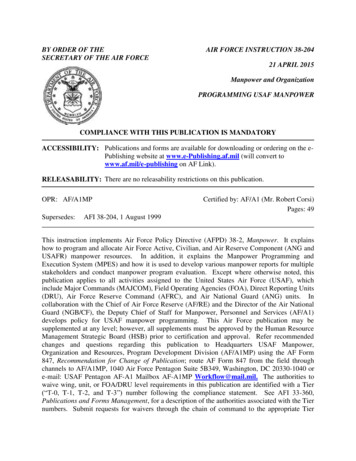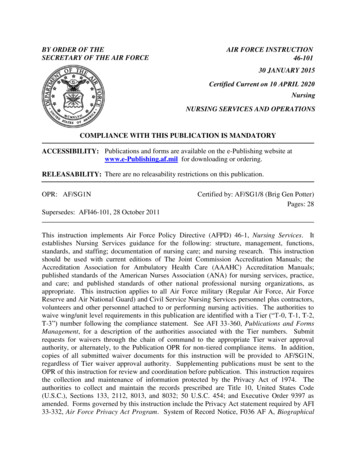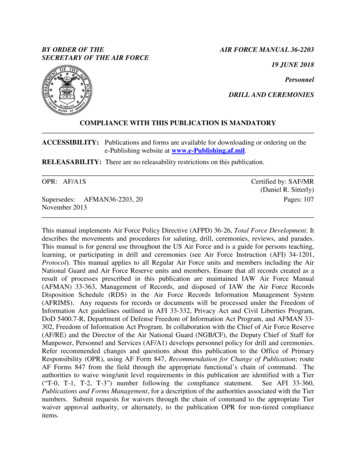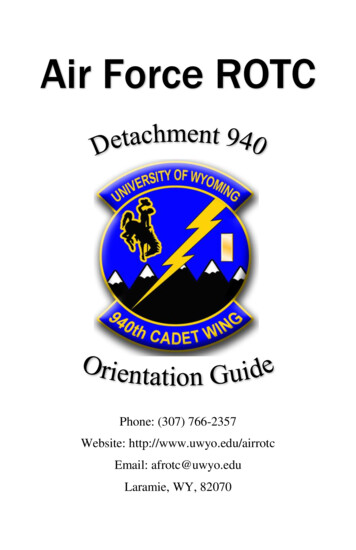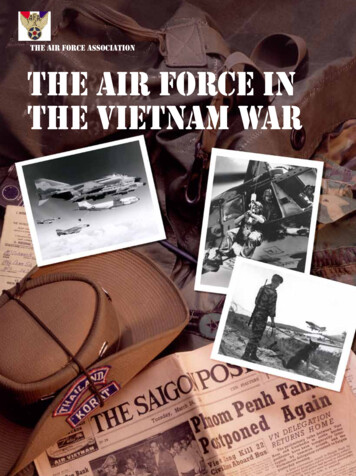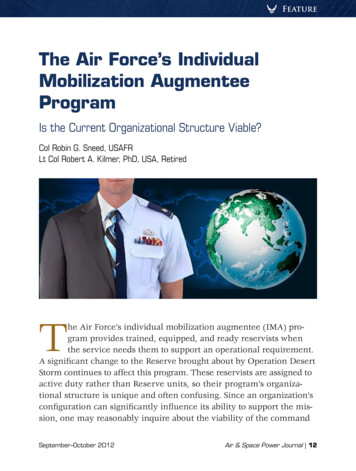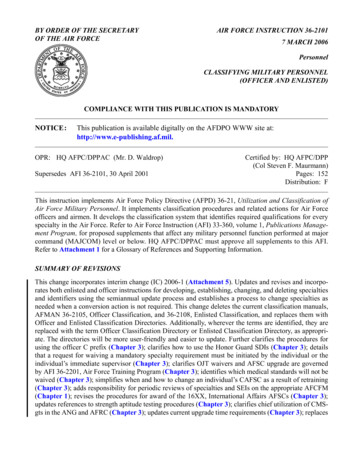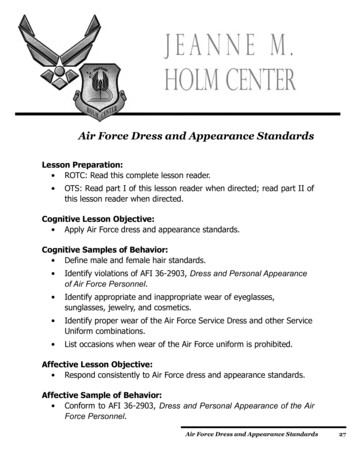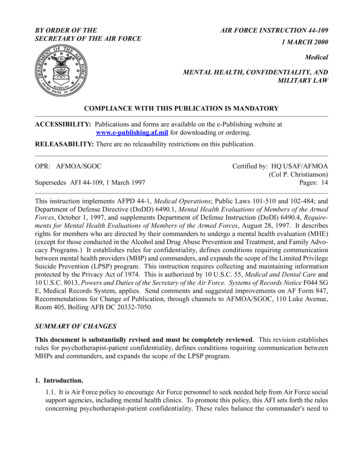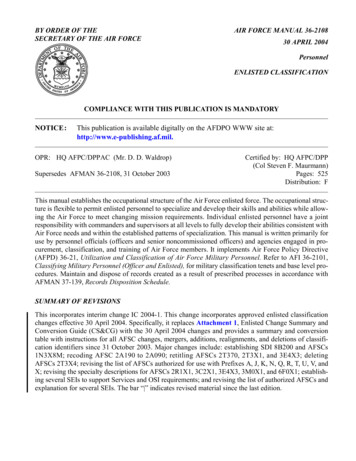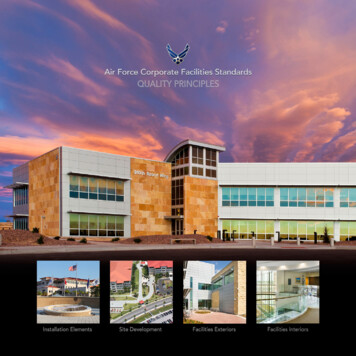
Transcription
QUALITY PRINCIPLESContinuing the Air Force’s operational success requires increasedadaptability, creativity, and deliberate investments in capabilitiesand readiness. High performance and sustainable facilities areessential to maintain an agile, flexible, and ready force. To beeffective, facilities must be appropriately planned, designed,built and operated. A principal objective is to support our highlysophisticated and capable Air Force by providing facilities thatenhance mission capability and reduce total ownership costs.Air Force facilities are to be accommodating and efficient, whilerepresenting strength, innovation and resiliency.After September 1947, when the Air Force was established as a separate service,the newly created department appointed the Stearns-Eisenhower Board to studyoptions for the U. S. Air Force Academy. From 1948 as a board chairman throughdesign and completion in 1958, President Dwight D. Eisenhower oversaw thecreation of the academy and advocated for its progressive architecture and campusdesign. Detailed written quality principles and standards were established at theoutset to ensure continuity in future facilities and to preserve the iconic quality andlegacy of the original structures.Honoring this rich tradition, the Air Force is pleased to present this most recentupdate of the Air Force Corporate Facilities Standards program (AFCFS), whichgoverns facility design for all Air Force communities worldwide. AFCFS reinforces akey Air Force paradigm of “Battle Ready Built Right!” and manifests these idealsin the design of its facilities to advance mission accomplishment and by providinghigh quality working and living environments. AFCFS’ Quality Principles emphasizethe importance of efficiency in the design of highly functional, safe and comfortableenvironments within a climate of limited resources and evolving criteria.The AFCFS program establishes an acceptable range of quality for Air Forcefacilities. Producing resource-efficient facilities with an appropriate level of qualityrequires a thorough understanding of systems, both the parts and the sumof the parts. Application of quality requires an understanding of long-term valuewhile balancing resources with operations, technologies and wellness. Creative andproficient implementation of AFCFS principles will ensure delivery of facilities thatadvance operations and accurately represent Air Force culture: an architecture thatpromotes and supports integrity, service and excellence.Cover Image310th Space Wing HeadquartersSchriever AFB, ColoradoJacobs, ArchitectPhoto CourtesyAir Force Civil Engineer CenterAir National Guard Readiness CenterCamp Springs, MarylandDMJM, ArchitectPhoto Courtesy Fennell Group
PURPOSE AND FUNCTIONAir Force facilities have two essential purposes:1) To efficiently support operations and mission accomplishmentwhile facilitating productivity, inspiration and comfort,2) To represent Air Force ideology and culture to personneland to the public.Facilities will be prudent, thoughtfully conceived, well-constructed,suitable for the climate, the context, the workforce, and will represent anappropriate level of quality as well as a sensible investment oftaxpayer dollars.Corporate-level guidance is defined initially in the AFCFS program.Guidance is subsequently defined in greater detail at the base level topromote local participation in the application and implementation ofpolicy. Air Force bases, through the Base Civil Engineer, are requiredto create and maintain Installation Facilities Standards (IFS) to communicate base-level standards for an acceptable level of quality for facilities.The IFS is a component of the Installation Development Plan, replacinglegacy Architectural Compatibility Plans.Facility Group 1Air Force Postgraduate Dental School and ClinicSan Antonio, TexasHoefer Wysoki ArchitecturePhoto CourtesyUS Air Force Civil Engineer Center“The purpose of architecture is to shelter and enhance man’s life on earthand to fulfill his belief in the nobility of his existence. . .”—Eero Saarinen
FACILITY HIERARCHYAir Force facilities are stratified into groups, creating a hierarchy of qualityinfluenced by their specific use and function and, often, their location onthe base. Accordingly, each facility on an installation is designated with aFacility Group number. An appropriate level of quality is then defined foreach facility group.Facility Group 1CentCom HeadquartersMacDill AFB, FloridaBurns & McDonnell, ArchitectPhoto Courtesy Fennell GroupThe highest levels of quality for buildings and their features, materials anddetails are assigned to Facility Group 1. These are the most prominentfacilities on an Air Force installation. Examples of Group 1 include headquarters buildings, medical facilities, base entrance gates and chapels.Facilities in Group 1 will display a dignified architectural character usinglong-lasting substantial materials and refined detailing, but withoutexcessive ornamentation. Group 2 facilities are designed to be less prominent than Group 1 with a visual character that represents a professionalimage using moderate detailing; the excessive use of architectural featuresand extravagant materials is inappropriate. Group 3 is reserved for industrialuses and Group 4 is for family housing.The value of materials and refinement of architectural detailing is directlyassociated to a building’s group number, which is essentially based on abuilding’s operations and prominence on an installation.Facility Group 2Base Operations FacilityMinot AFB, North DakotaLeo A Daly, ArchitectPhoto CourtesyUS Air Force Civil Engineer CenterFacility Group 3F-22 HangarHickam AFB, HawaiiBurns & McDonnell, ArchitectFacility Group 4Family Housing, Facility Group 4MacDill AFB, FloridaTorti Gallas and Partners, ArchitectPhoto CourtesyUS Air Force Civil Engineer CenterPhoto CourtesyUS Air Force Civil Engineer Center“The details are not the details. They make the design.”—Charles Eames
Facility Group 1Santa Maria Visitor CenterVandenberg AFB, CaliforniaFennell Group, ArchitectPhoto CourtesyUS Air Force Civil Engineer CenterFACILITY QUALITYAir Force facilities shall have a level of quality appropriate for theirFacility Group designation. Building sites, architectural features, materialsand detailing should appropriately reflect the desired quality related to thefacility group number.Extravagance is inappropriate. Designs are to be cost-effective, integratingeconomy into building systems that visually express an appropriate levelof quality. Each facility design will be responsive to its site and immediatesurroundings, to the local climate and to the local context by employingregionally appropriate features and materials.Highly durable, low-maintenance materials and details are to be providedfor all facility groups. Facilities are to be designed to withstand use associated with operations as well as climatic forces and weathering. The requiredlevel of quality is to be maintained when integrating antiterrorism/ forceprotection measures.Facility Group 2F-35 Academic Training CenterLuke AFB, ArizonaBurns & McDonnell, ArchitectPhoto CourtesyUS Air Force Civil Engineer CenterFacility Group 3Maintenance HangarReno, NevadaH K ArchitectsFacility Group 4Family HousingWhiteman AFB, MissouriDesign West ArchitectsPhoto CourtesyUS Air Force Civil Engineer CenterPhoto CourtesyUS Air Force Civil Engineer Center“Quality is never an accident. It is always the result of intelligent effort.”—John Ruskin
FACILITY DISTRICTSTo create and maintain visual continuity for sites and facilities on Air Forceinstallations, “Facility Districts” may be designated. A Facility District is aunique visual zone with a distinguishable architecture and readily identifiableboundaries. A district’s consistent visual character is typically discernedin similar form, scale and materials. Examples of Facility Districts includehistorical areas, flight lines, housing areas or campuses.Facility Districts express visual coherence and continuity, which mayelevate the overall level of visual quality without additional costs. Sitesand buildings within a Facility District will comply with quality standardsfor each Facility Group and the base’s Installation Facilities Standards.Facility DistrictFamily Housing, Facility Group 4MacDill AFB, FloridaTorti Gallas and Partners, ArchitectPhoto Courtesy US Air Force Civil Engineer Center
SITE DEVELOPMENTGrounds and landscaping will complement the architecture andwill be expressive of an integrated whole, consistent with therespective facility group or district. Landscape materials will be sustainable and comprised of indigenous species that reduce relianceon potable water resources for irrigation. Existing site resources,such as mature trees, will be preserved wherever practical.Utilities, infrastructure and other site elements will utilize an integrated design approach to align on-site engineered systems withthe environment. Sites and climate, including local and regionalcontexts, will be analyzed to optimize a building’s orientation,configuration and massing. Preference will be given to previouslydisturbed/developed areas.FACILITY DESIGNDesign and engineering of facilities will incorporate innovativeand resourceful methods, systems, technologies and materialsappropriate to the Facility Group, operational type and locale.Considerations include selection of materials and details, integrated on-site energy and water management, energy resiliency,climate responsive design strategies, climate resiliency, architectural compatibility, antiterrorism/force protection, and reducedongoing operations, energy and maintenance costs.Facility Group 1Ambulatory Care CenterJBSA Lackland AFB, TexasHDR, ArchitectPhotos Courtesy Fennell GroupWhenever possible, sites and buildings will be compatible withsurroundings thus forming a part of the overall community. Thedesign of buildings and sites will undergo a comprehensiveprocess of understanding and balancing requirements that willbe incorporated into a cohesive and inspiring whole. The AirForce Civil Engineer Center (AFCEC) will evaluate facility designson the basis of functionality and efficient performance, and onhow well the design follows AFCFS. Designs are to be highlyfunctional yet flexible to meet changing operational requirements while enduring heavy use and climatic forces over time.Air Force buildings are to be accommodating and efficient, whilerepresenting virtue, strength, innovation and resiliency.SAFETY AND SECURITYProviding safe and secure working and living environments for allpersonnel, staff and visitors is paramount. Designs and construction will meet or exceed all antiterrorism/force protection standardsand specifications. Architects and engineers will be incessantlychallenged to develop methods, materials and solutions tothoughtfully integrate security measures into overall designs without compromising visual quality.SUSTAINABILITYBuildings and sites will comply with federal guidelines for HighPerformance and Sustainable Buildings (HPSB). These include: Employ Integrated Design Principles Optimize Energy Performance Protect and Conserve Water Enhance Indoor Environmental Quality Reduce Environmental Impact of Materials Promote Sustainable Location and Site DevelopmentCost-effective passive and design strategies and features areencouraged. Climate responsive design solutions for shading,heating and cooling will be integrated into facility and site designs.Building orientation, which directly impacts energy efficiency andperformance, is a principal consideration and will integrate High Performance and Sustainable Building strategies for form and demarcation, thermal envelopes and components. Architectural features willbe environmentally functional to provide protection from inclementweather, to buffer winds and to promote natural ventilation, summershading and winter solar gain as applicable for the locale.Materials selection as well as construction, maintenance andoperations practices will be sustainable. Particular attention willbe given to the local context, specifically to enduring architecturalfeatures and use of regional materials in response to local climaticconditions. Levels of quality will be integrated with features, materials and details that satisfy stipulations for High Performance andSustainable Buildings (HPSB) and Air Force Sustainable Design andDevelopment (SDD) guidance.
ARCHITECTURE AND ENGINEERINGArchitects and engineers, who are skilled in addressing the local climate and context, willbe engaged to ensure an emphasis on High Performance and Sustainable Buildings andan expression of Air Force ideals.CONSTRUCTION AND CRAFTSMANSHIPConstruction professionals will be engaged throughout the process to ensure foremostimplementation of the design. The Air Force is committed to using the best constructionpractices and craftsmanship possible, within budget constraints, and to selecting themost experienced and credentialed building contractors.OPERATIONS AND MAINTENANCEOperations & maintenance (O&M) professionals will be engaged throughout the designand construction process. Facilities will be economical to operate & maintain, and willutilize durable materials that are suitable for the application. Designs will be based onlife-cycle cost analysis that considers long-term operations, utility use and maintenanceconcerns. Design intent and features will be maintained throughout the life of the facilityusing the best stewardship practices. O&M personnel will be trained on maintaining theperformance of building systems.HISTORICALLY SIGNIFICANT PROPERTIESThe Air Force is proud of its heritage and is committed to preserving its historical, cultural andarchitectural legacy. All possibly significant AF facilities and archaeological sites are evaluatedagainst specific criteria spelled out in the National Historic Preservation Act regulations at 36CFR 60.4. Historical or archaeologically significant properties are determined to be eligiblefor listing in the National Register of Historic Places (NRHP).Edward J. Peterson MuseumColorado Springs, ColoradoEarle A. Deits, ArchitectPhoto Courtesy Fennell Group“We shape our buildings; thereafter they shape us.”—Winston Churchill
This Air Force Corporate Facilities Standardsdocument is available on the World Wide Weband is printed in limited quantities to promoteenvironmentally responsible practices.This document is printed on 100% post-consumerwaste fiber, which is manufactured with nonpolluting wind-generated electricity and certifiedby Green Seal for Forest Stewardship Council(FSC) standards.Eco-friendly “bio” inks with low VOCs are usedfor this printing to reduce environmentalimpacts. Inks are free of toxic air contaminantsas defined in the Federal Hazardous Air Pollutantslist; meet the requirements of the Nordic SwanEcolabel criteria as to chemicals, emission to airand water, and waste treatment; and comply withMontreal Protocol on Substances that Depletethe Ozone Layer.RecycledSupporting responsibleuse of forest resourcesU.S. AIR FORCEAFCFSwww.afcfs.wbdg.org
Schriever AFB, Colorado Jacobs, Architect Photo Courtesy Air Force Civil Engineer Center Cover Image. Facility Group 1 Air Force Postgraduate Dental School and Clinic San Antonio, Texas Hoefer Wysoki Architecture Photo Courtesy US Air Force Civil Engineer Center . Edward J. Peterson Museum Colorado Springs, Colorado Earle A. Deits, Architect
